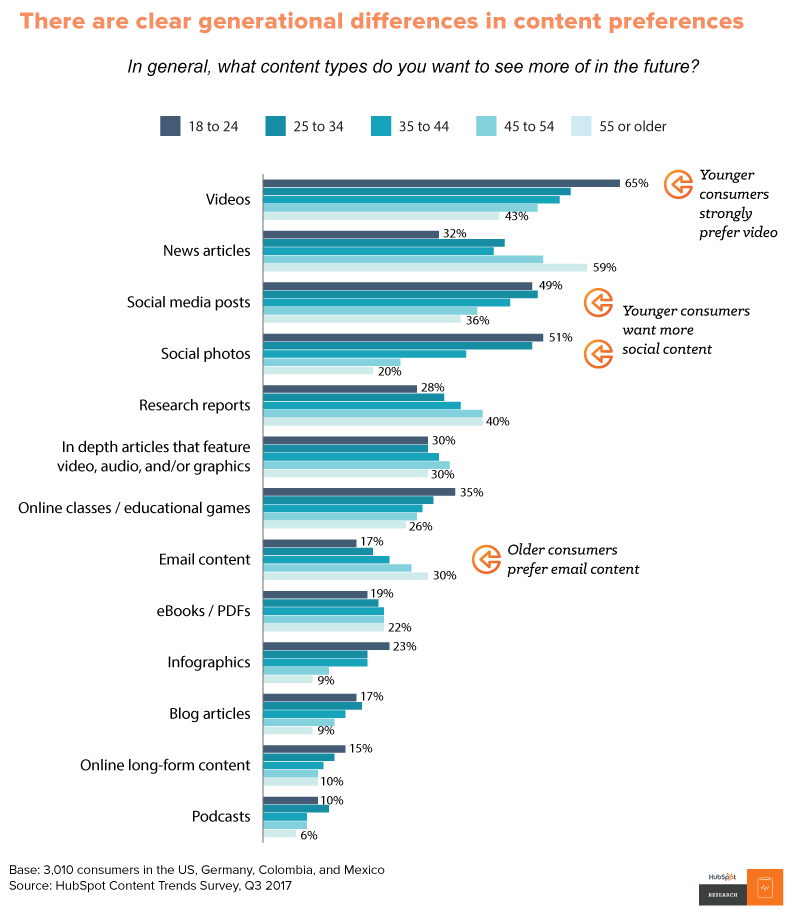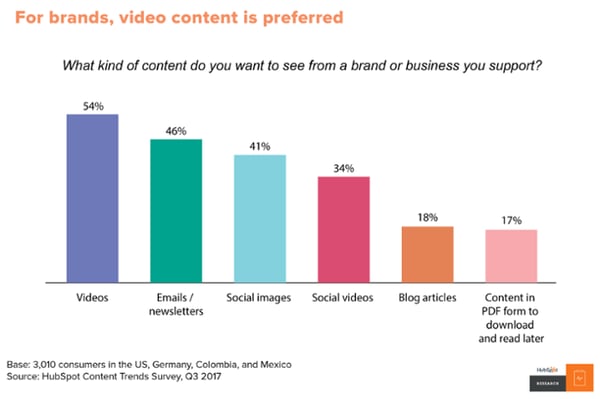Triggered by a shift in consumption habits, a new wave of broadcasting platforms and fierce competition for audiences, video content marketing looks to be undergoing a face-lift.
One of the biggest changes concerns the way that people consume this particular format. The increased use of mobile devices has enabled digital content managers to communicate with audiences in ways they never thought possible, forcing them to re-evaluate their approach to video’s production and distribution.The convenience of being able to watch videos whenever and wherever is creating a greater demand for clips and access. Video is now the number-one choice for branded content - a situation which is creating plenty of opportunities for content owners to monetize off the back of it.
If one thing is for certain, it’s that the future of video content marketing will not be defined by a single trend. It will encompass many different factors and considerations that will cause businesses to adapt the ways they attract, maintain and engage their audiences.
Wildmoka’s service is a reflection of the measures that digital content professionals are having to implement in order to make an impression. We see the following as big considerations for video content marketing going forward:
- Changing audience behavior
- The next generation of broadcasting platforms
- More competition for audiences
- New monetization opportunities
- Full digital transformation
Digital content professionals are operating in an increasingly challenging environment, but help is on the way.
Read on to discover the future prospects of one of the most exciting content formats around, with advice on new methods of content distribution, video monetization, platform utilization, and more.
Changing audience behavior
![]() One of the biggest stakeholders in the future of video content marketing are the people that drive it.
One of the biggest stakeholders in the future of video content marketing are the people that drive it.
Today’s audiences have access to a range of devices and connections which have influenced the way they access and consume video content. The explosion of ‘on-demand’ services like Netflix shows that people like being able to watch things on their own schedule, regardless of when it was initially aired.
Global viewing figures suggest that live events including the World Cup Final and Super Bowl will always attract an audience. Away from that small cluster of one-off spectacles, there is a need to enable the audience a chance to consume content in a way that is suitable for them.
Another big consideration for digital content managers is the window for engaging an audience. Microsoft outlines that humans have an average attention span of eight seconds, down from 12 in 2000, which could explain the success that brands are having with shorter videos, especially in front of a younger audience.
Finally, there is the gateway of the content to consider - a point which signals an even greater driving of views and audiences via mobile devices. For example, did you know that:
- Nearly half (45%) of web users predict an increase in their consumption of video through mobile devices, owing to shorter clips and the ability to watch them on the move.
- Audio and video will account for 89% of consumer data traffic by the end of 2018.
- Popular social network Twitter says 90% of its video views come from mobile devices.
As video becomes all the more fueled by mobile, the demand for content is ramping up. When HubSpot asked over 3,000 US consumers to state the content format they’d like to see more of, video proved unanimously popular across all age groups.

Our technology is facilitating better access to content in general. Video is a popular format, but the reducing of attention spans, combined with the influence of smaller screens, is changing the way it needs to be delivered.
Video content managers can respond by capturing users in the moment. They can even take inspiration from broadcasters, who are investing in technology that allows them to share key snippets from live events to prolong their impact.
In terms of content length, there is an argument that shorter clips are more suited to smaller screens and attention spans. Providing that option in addition to a lengthier clip (or maintaining live coverage of an event) would seem like the smartest move.
The next generation of broadcast platforms

If video marketing is about capturing an audience in the moment, our marketers need to be delivering content in the areas where they’re most likely to be.
Social media is one place where video consumption is growing rapidly. Facebook claims that eight billion clips are watched on its platform every day, with views of branded content rising 258% year on year in 2017.
Don’t forget that virality can really impact how successful a video is in terms of reach and engagement. Audiences will actively share clips they enjoy, and social platforms make it possible to do this through the click of a button.
Businesses and broadcasters have also seen the value in online video portals for offering a roundup of content around specific events and topics of interest. Making things more impressive is the use of automation to edit and upload these clips to remove any strain on resources and accelerate the process of delivery.
What’s important for marketers and content owners is to follow their audience.
Beyond examining their analytics on each platform, competitor analysis and audience surveys will show where the interest is headed.
Snapchat estimates that 10 billion videos are viewed on its network every day, but content owners should be mindful of how quickly that momentum can shift. The rapid demise of services like Vine and MySpace should come as a warning to those with strategies that are too centered around one distribution outlet.
In anticipation of more than one platform being suitable, content owners should be clipping and repurposing video content for use on multiple channels. As well as making good use of their existing assets, these activities will also help with their future-proofing efforts should one platform start to wane.
More competition for eyeballs

As more videos are consumed and demanded, we can expect their volume of producers to enjoy a similar rise.
Research from HighQ shows that 69% of today’s marketing, sales and business pros have used video marketing to convey a message, while the additional 31% plan on doing the same in the future.
Businesses are now publishing an average of 18 videos per month - an output that really should highlight how much they value their online audiences.
At a glance, we’d estimate that the future of video content marketing is bright. More investment will be dedicated toward targeting an audience whose appetite for the format looks to be speeding up, rather than slowing down.
There will however be more competition for viewers. Every professional should be keeping up with the latest video-related trends to ensure they are producing, distributing and measuring content in the right way.
Their ideas should be fresh and relevant, delivered in an effective manner and on the right platforms. Complacency will only result in them falling victim to the noise.
New monetization opportunities

WIth 64% of users more likely to buy a product after watching a video about it, the format now represents a huge opportunity for monetization
From the below we can see that consumers list video as their preferred choice for branded content - above emails, social images and blogs - and businesses should be assessing how they can generate a return from their multimedia investment.
For guidance in creating a purposeful video marketing strategy, take the example of auto brand Volvo and its use of the format in targeting truck drivers at the start of their purchase journey.
Broadcasters and content owners can take a slightly different approach by integrating ad spots, just like the example from Volvo, within their video assets. This would provide a way of transferring some of their knowledge and success with linear platforms like TV, onto the online world.
Social networks like Facebook and Twitter are primed to help these companies in broadcasting moments from live events, with graphics and pre-roll ads helping them meet their sponsorship requirements.
Analysts are predicting a continued flow of ad dollars from TV to digital formats as brands and content owners chase their audiences from offline to online. That shift will trigger a series of events, according to eMarketer, like Facebook and Google outscoring TV in terms of ad revenue by 2018.

In the next few years, brands and content owners should be testing a series of different monetization formulas in order to create new streams of revenue from online video. The time for experimentation is now, and the forward thinkers have already started preparing.
Digital transformation

The final consideration for anyone with a vested interest in the future of video content marketing should be the digital transformation happening around them.
In 2018 and beyond, it is not enough to simply have a Facebook presence or a semi-regular distribution of video content to a couple of online channels. Our organizations must be digitally minded and ready to abandon some of their oldest processes and strategies with a view to making online a priority.
One of the biggest changes will concern how they approach live events. The leading broadcasters are agile in their reporting; they can react to key moments with snippets of professionally edited clips that position them as the authority on the situation.
In the aftermath, they have the tools to extend its lifespan and impact. These outfits accept that not every user wants to sit through an entire broadcast and can offer different levels of their service to suit all the relevant parties.
Compared with their former selves, they are digitally transformed. That same change is happening across several industries - like healthcare, manufacturing and insurance - so it’s important to define what we mean by that transformation within the field of content production.
Video content will become an area where its leaders will display the following traits:
- Embracing of multiple platforms to maximize an audience.
- Able to prolong the impact of a live event through highlight reels and other assets.
- Equipped with technology that enables the speedy sharing of content at key points.
- Capable of basing ideas and strategies on measurements of views, engagement, sales and other metrics.
How Wildmoka is helping content owners embrace the future of video
Digital transformation is set to impact so many areas of the marketing mix, but video will be one area where the changes are most evident.
Video content professionals will need to leverage a new line of technology to embrace the future of the format. These solutions must facilitate actions like the rapid sharing of clips, and without this having a drain on their resources.
Wildmoka is a video digital creation platform that is uniquely positioned to help marketers, content owners and broadcasters to reach new audiences, increase engagement and drive completely new streams of revenue from their existing assets.
Its video solutions enable the following:
- The clipping of live broadcasts for the instant sharing of events across web, mobile and social media
- Automated production of clips, enabling the fast and efficient delivery of content
- The unlocking of new monetization opportunities within online video
- The empowering of staff via an easy-to-use solution
Video is set to become a highly competitive space to operate in. Over half of the global population is online , but that audience will only represent an opportunity for those who can produce and distribute content in a certain way.
Wildmoka is allowing content managers to position their assets in the right places and at the right times to capture their audience’s attention. That means whether they’re promoting a live event, or one that’s already happened, they have the tools to do it justice.
Key takeaways
Video content marketing is headed for some interesting and exciting places. A combination of bigger audiences and more investment will always paint the picture of a bright and promising future. Yet, challenges stand in front of anyone who wishes to take advantage.
For content managers, the big considerations going forward are:
- Decreasing attention spans could influence the average length of content
- Video is being consumed in several different places and new platforms are emerging
- Social media is one of the fastest growing places for the consumption of video
- Mobile should represent a big consideration for anyone producing video content
- Video output is likely to rise as the demand for content increases
- Content owners and broadcasters are preparing for the future by undergoing digital transformation
- Technology can ease content producers into the new era of video content marketing
- Decreasing attention spans could influence the average length of content
References:
- https://www.adweek.com/digital/john-stevens-guest-post-decreasing-attention-spans/
- https://www.adweek.com/digital/new-study-shows-millennials-prefer-short-mobile-videos-while-older-crowds-long-form-170739/
- https://www.socialmediatoday.com/social-business/facebook-releases-new-report-video-consumption-behaviors-facebook-and-instagram
- https://www2.deloitte.com/content/dam/Deloitte/in/Documents/technology-media-telecommunications/in-tmt-rise-of-on-demand-content.pdf
- https://venturebeat.com/2015/05/13/90-of-twitter-video-views-happen-on-a-mobile-device/
- https://research.hubspot.com/content-trends-preferences?_ga=2.147861621.395291586.1536571869-1548712441.1487696545#video
- https://www.ecaeurope.com/media/4148/pwcs-sports-survey-2017.pdf
- https://techcrunch.com/2016/01/27/facebook-earnings-q4-2015/?guccounter=1
- https://www.bloomberg.com/news/articles/2016-04-28/snapchat-user-content-fuels-jump-to-10-billion-daily-video-views
- https://tubularinsights.com/sponsored-content-q2-2017-report/
- https://www.digitalinformationworld.com/2016/12/infographic-video-marketing-statistics-2017.html
- https://blog.hubspot.com/marketing/video-marketing-statistics#sm.00000qyqiaiyyvf8oqm6ogkn4ztpq
- https://research.hubspot.com/charts/branded-video-is-preferred
- https://www.youtube.com/watch?v=M7FIvfx5J10